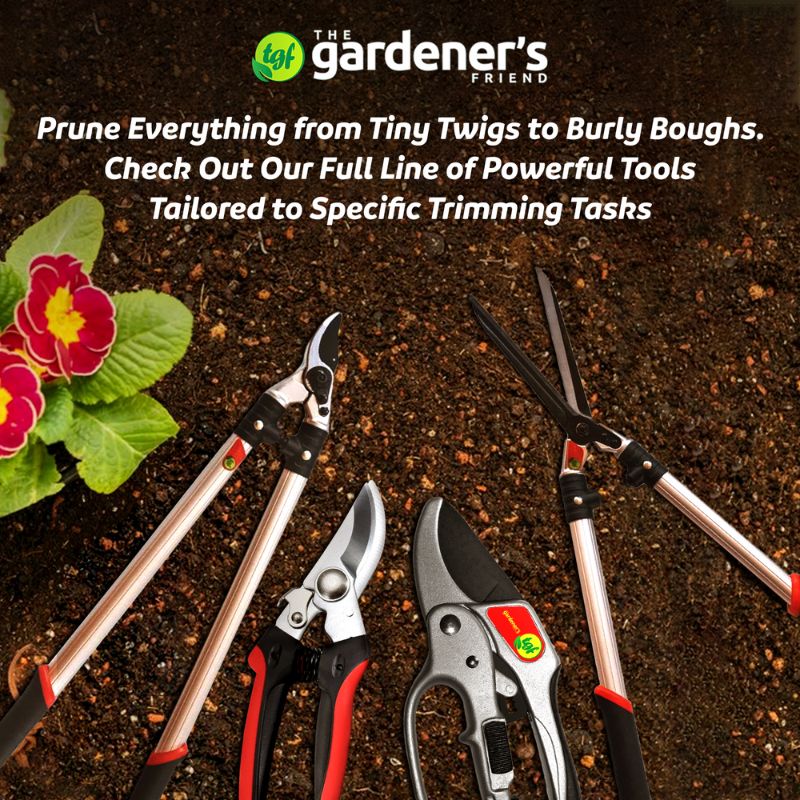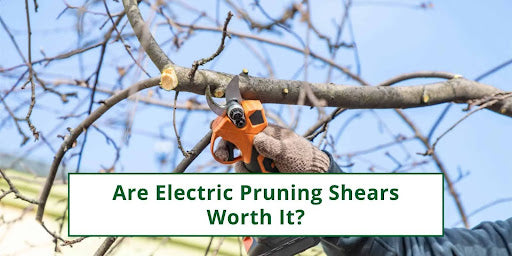Whether you take care of your backyard or are a professional landscaper offering services, you need to be great at pruning.
Manual pruning keeps your garden neat and plants healthy, but it can put strain on your hands and wrists.
Electrically-powered pruning shears take the stress off your wrists, doing the heavy lifting for you. But, are they worth the price?
In this post, we’ll address a commonly asked question, “Are electric pruning shears worth it?” from different aspects.
Let’s dive in.
The Burden of Manual Pruning and Why You Need an Alternative
Here are some reasons you might want to give up manual pruning.
Repetitive Strain Injury (RSI)
Hours of squeezing can cause hand fatigue and even injuries. If you’re a professional who prunes a lot or a homeowner with a large garden, consider switching to electric pruners.
Time Consumption
Manual pruning is slow and time-consuming. You have to reposition the pruner and apply effort for each cut.
Limited Capacity
It’s impractical to tackle a big garden with a manual pruner. And if you’re doing it frequently, the process becomes physically demanding.
Electric Pruning Shears (How They Work)
Electric pruning shears use an electric motor to drive the cutting blade, with a simple push of a button or lever.
They dramatically reduce hand fatigue and increase your gardening efficiency.
Pros of Electric Pruning Shears
Let’s discuss the reasons to shift to an electric pruner.
Minimize Hand and Wrist Fatigue
The number one benefit you get by using an electric shear is less hand and wrist fatigue.
Unlike manual ones, you don’t have to squeeze it thousands of times, minimizing the risks of strain and injury.
This makes electric pruners perfect for:
- Gardeners with limited hand mobility or grip strength
- Elderly gardeners
- People with conditions like arthritis
Significant Time Savings
The second most important benefit is the amount of time you can save. An electric pruner makes cuts with a simple trigger pull.
When you’re sifting from a manual pruner, you’ll easily notice a significant increase in the number of clean cuts you can make within a short period.
Consistent, Clean Cuts
A sharp blade powered by a motor typically makes cleaner cuts more consistently. More clean cuts mean fewer chances of plant diseases and pathogens.
Easier Cutting of Thick Stems
Manual pruners are meant for thin stems and branches. Electric ones can cut as thick as ¾ inches easily.
You May Also Like: Gardening Saw Vs. Pruning Shears (A Comparison)
Cons of Electric Pruning Shears
While electric pruners offer convenience and efficiency, they have their cons. Consider them before buying them:
Higher Upfront Costs
This is probably the most prominent barrier; electric pruners are expensive than their manual counterparts.
Even premium manual pruners ($40 - $80) cost less than an electric shear ($100 - $300+). When you buy this tool, you pay for the motor, battery, and the engineering.
Battery Dependency
You’ve got limited runtime with a battery-powered tool. Even the best batteries (Typically lithium-ion) last between 1 - 3 hours on a single charge. Heavy-duty cutting drains them even faster.
Plus, before you can use these shears, you’ll have to charge them for about a couple of hours. And for bigger tasks, you may need to keep spare batteries with you (Additional cost of $50 - $100+ per battery).
Added Weight
Unlike manual shears, they have a battery and a motor, which adds extra weight. While there’s no squeezing action, you still need to hold and maneuver the tool. Extended use can cause arm and shoulder fatigue.
Maintenance Complexity
With manual shears, maintenance is typically limited to the blades. But with the electric ones, there’s a battery and motor to take care of.
Repairs are generally more complex and costlier than fixing manual pruners.
Not Ideal for Precision Pruning
For tasks that require good control, such as cutting tiny stems or intricate bonsai, manual shears are the best option.
Key Factors to Consider: Is It Right for You?
While the answer may vary from situation to situation, some factors to consider are:
Volume of Pruning: For high-volume pruning, like large estates, electric shears are totally worth it.
For low-volume tasks, they’re probably not worth the cost.
Physical Considerations: Electric pruners are ideal for people with hand issues. The fact that you can do gardening pain-free alone justifies the cost.
Budget: Can you afford to invest the upfront amount in exchange for years of efficiency and comfort?
Who Should Consider Electric Pruning Shears
For many users, the benefits of an electric pruner justify the initial investment. Consider them if:
- You experience hand or wrist pain due to manual pruning
- You’re maintaining large hedges and gardens
- You’re a flower farmer
- You want to save time and maximize gardening efficiency
Are Electric Pruning Shears Worth It: FAQs
Let’s address some popular questions related to electric pruning shears.
What Precautions Should Be Taken When Using Electric Pruning Shears?
Always engage safety locks when carrying these shears, wear protective gloves while using them, and make sure branches are within the tool’s maximum cutting capacity.
How Long Does the Battery of Electric Pruners Last?
An electric pruner’s battery typically lasts between 1 - 3 hours, depending on two factors: The intensity of use and the battery size (Ah rating). Heavy cutting drains batteries faster than light trimming.
Are They Worth The Price for a Home Gardener?
Yes, they’re worth the price if you have hand pain, arthritis, or just prefer convenience. For small gardens with minimal pruning, manual shears are a better choice.
Can Electric Shears Replace Manual Shears Completely?
No, electric shears excel at cutting thick stems and are ideal for repetitive cuts, but they’re not great at delicate tasks. For precision work, manual shears remain the right option.
Conclusion
Electric pruning shears have undeniable benefits; they reduce hand fatigue, make clean cuts at scale, and handle thick branches easily.
The fact that they do all the heavy lifting makes them a natural choice for elderly gardeners or people with limited hand strength.
And since they offer convenience, speed, and efficiency, they’re a great option for professional gardeners.
However, there are some cons to be aware of; they’re expensive, depend on battery power, and can be heavy. Plus, remember that they don’t completely replace manual pruners. For delicate tasks, you’d still require manual pruners.


